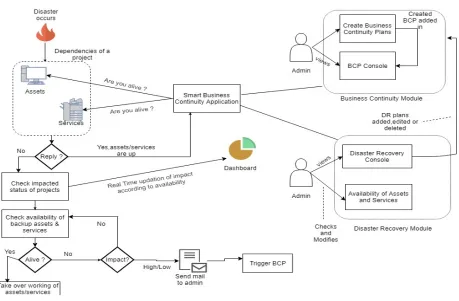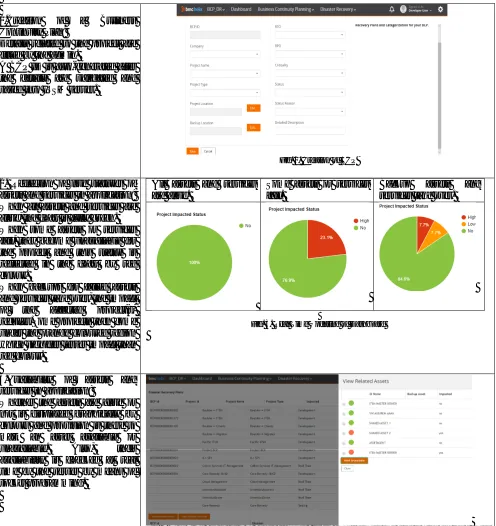Smart Business Continuity Application
Piyush Hajare1, Ashish Kshirsagar2, Kritika Patade 3, Madhura Pawar 4, Yogesh Handge 5
B.E. Student, Department of Computer Engineering, Pune Institute of Computer Technology, Pune,
Maharashtra, India1,2,3,4
Assistant Professor, Department of Computer Engineering, Pune Institute of Computer Technology, Pune,
Maharashtra, India5
ABSTRACT: In the current scenario, the Business Continuity Plans (BCPs) and Disaster Recovery Plans (DRs) in organizations are written using typical word processing tools. The monitoring of projects and triggering of these plans must be done manually. Here, we propose a Smart Business Continuity Application which shall allow an end user to store the BCPs for various projects of an organization in an Information Technology Service Management (ITSM) server. As soon as an asset or a service goes down due to a disaster, its backup, as mentioned in the project’s BCP, takes over its working. The admin of the organization is automatically notified of such incidents and he can check status of impacted projects at a glance. There is a provision to trigger BCPs for severely impacted projects by a single click.
KEYWORDS: Business Continuity Planning, Disaster Recovery, ITSM.
I. INTRODUCTION
Smart business continuity application deals with the continuation of business in adverse circumstances. The system consists of two parts: business continuity planning and disaster recovery planning. Business continuity involves the processes and procedures an organization must implement to ensure that mission-critical functions can continue during and after a disaster. Disaster recovery comprises specific steps an organization must take to resume operations following a disastrous incident. A business consists of entities like people, assets, services, etc. When incidents like fire, flood, network failure, breach of cyber security, etc. occur, these entities can get affected and may take indefinite time to resume working. This can disturb the continuity of the processes they are associated with.
Every organization must have predefined business continuity plans for its projects. In the traditional framework, these plans are documented manually. The admin has to keep monitoring the assets and services of all the projects himself. When a disaster occurs, he has to first refer to the BCP document and then give instructions accordingly. This consumes time and the continuity of projects is disrupted.
In the proposed system, we model a smart business continuity application that allows an end user to store a project’s BCP details in the ITSM server.
II. RELATEDWORK
Dr. Manik Dey, in [5], has explained the importance of a business continuity plan for every business. No business is free from any kind of known or unknown disaster and hence, all businesses should be ready to face any kind of threats and ensure that the working of the businesses is not disrupted.This can be done by identifying the fields which are most crucial for a business. Risks to various areas in the business process should be assessed and steps that should be taken to handle the vulnerable functions should be decided.He has also put forth a BCP lifecycle which includes identification of key business services, documentation of different dependencies across projects, specifications of recovery, implementation of solutions, testing and validating proposed measures and maintaining them.He has mentioned that the BCPs should abide by some standards which have already been established in order to ensure that the BCPs are able to tackle all aspects of continuity of businesses. Some of these standards are BS 25999-1 / 2,ISO-27031,ISO-22399,MS 1970,HB 221, TR 19, NFPA 1600.
In [3], a metric called risk exposure is calculated, which calculates the effect of potential threats and the business loss caused by them. For a single threat, the risk exposure is the product of following probabilities: the probability that the attack will occur(T(t)), the probability influenced by the attack (V(t)) and the cost of the consequences of the attack succeeding(C(t)).Thus, for a single service(S), the total risk exposure from several threats can be stated mathematically as,
R(S) = ΣT(t)⨯V(t)⨯C(t)
Risk exposure can be calculated by generating mapping tables between vulnerabilities, threats and their proactive measures. The probability of occurrence of threat is calculated by the frequency of past threat occurrences recorded in the database.
III.PROPOSEDSYSTEM
The proposed system workflow is shown in fig. 1.
The Smart Business Continuity Application has three main functional modules as follows: 1. Business Continuity Planning module
2. Disaster Recovery module
3. A module which continuously monitors the availability of assets and services.
The Business Continuity Planning module allows the admin to create a Business Continuity Plan(BCP) in which provision is provided to store the name of organization to which the project which might be affected by some disaster to be stored along with the name of the project ,its type ,the location of project ,the backup location ,the criticality of project ,the Recovery Time Objective (RTO) , the Recovery Point Objective(RPO), the status of BCP that is, whether it is approved, closed, reviewed or in draft ,et cetera along with the status reason and also the detailed description of that BCP.
reflected in the form of percentage of impact change on the dashboard.If the status of impacted projects changes from no-impact to low-impact or high-impact,an email is sent to admin stating the defect promptly.The admin then logs in to the applicationand takes a decision whether to trigger the BCP or not.
Fig. 1. Proposed System Workflow
IV.IMPLEMENTATION
The Smart Business Continuity Application has been implemented based on the proposed model discussed above.As the application is tailored to be used in software companies,we have considered a sample data of projects,team members working for a project,names of assets and services.The data is hosted on an ITSM(Information Technology Service Management) server where in it is fetched using AR (Action Remedy) Server APIs of Java. This data fetched from server is further sent to the required front end forms using REST(Representational State Transfer) APIs in the form of JSON objects.The data is received and parsed using AngularJS
SIMULATION AND RESULTS
1.Creation of a Business
Continuity Plan:
Details related to the project are filled by the admin.
A BCP ID is auto-generated after the details are validated and saved into ITSM server.
Fig. 2. Creation of BCP
2. Reflection of live statuses of assets and services in application: When all assets and services are alive, the chart is fully green. When some assets or services fail, they become unavailable for the project and this status is reflected in the chart by red colour.
When backups for failed assets and services take over, the impact
of the affected project(s)
reduces.Some projects then come under the orange coloured region which signifies lesser impact than red colour.
All assets and services are alive.
Some assets or services fail.
Backup assets and
services take over.
Fig. 3. Real Time Updating of Dashboard
3.Availabilty of assets and
services in application:
Whether the assets are alive or not is displayed graphically by colours and provision is there to mark an asset available or
unavailable. Also, their
V.CONCLUSION
In this model, we proposed a smart business continuity application using an ITSM server which monitors projects and notifies admin of impacted assets or services automatically. The system would be capable of giving a spontaneous real time overview of the statuses of all projects; the statuses of all assets and services (alive or not alive) would be checked continuously and reflected in the application at real time. This system can be integrated with any organization and the organization’s server itself can monitor the statuses of its assets and services.
Future scope of this system includes the implementation of a call tree and the provision to test a BCP.
REFERENCES
[1] Rahul Gurnani, Kaushik Pandey, Shashi Kant Rai, "A scalable model for implementing Cyber Security Exercises", Computing for Sustainable Global Development (INDIACom) 2014 International Conference on, pp. 680-684, 2014.
[2] Hiroki Nishiyama, Katsuya Suto, Hideki Kuribayashi, "Cyber Physical Systems for Intelligent Disaster Response Networks: Conceptual Proposal and Field Experiment", Network IEEE, vol. 31, no. 4, pp. 120-128, 2017.
[3] Quan Guo, Zhiqiang Zhan, Teng Wang, Xiaodong Zhao, "Risk assessment and optimal proactive measure selection for IT service continuity management", Network Operations and Management Symposium (NOMS) 2012 IEEE, pp. 1386-1391, 2012.
[4] Marko Niemimaa, "Information systems continuity process: conceptual foundations for the study of the ‘social’", Computers & Security, 2016. [5] M. Dey, "Business Continuity Planning (BCP) methodology — Essential for every business," 2011 IEEE GCC Conference and Exhibition (GCC), Dubai, 2011, pp. 229-232.
[6] R. J. Kepenach, "Business Continuity Plan Design," Second International Conference on Internet Monitoring and Protection (ICIMP 2007), San Jose, CA, 2007, pp. 27-27.
[7] M. S. Fernando, "IT disaster recovery system to ensure the business continuity of an organization," 2017 National Information Technology Conference (NITC), Colombo, 2017, pp. 46-48.

